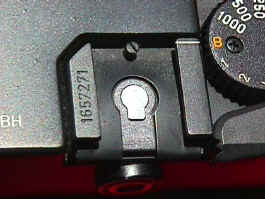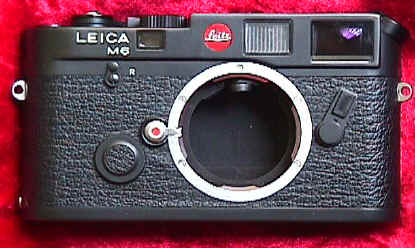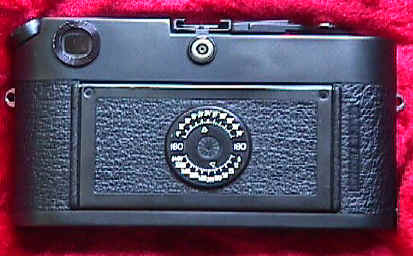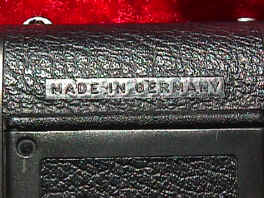 Early
vs. Late M6
Early
vs. Late M6Home Camera Articles FOR SALE Orders I Buy / Wants Repairs Books Adapters
 Early
vs. Late M6
Early
vs. Late M6
M6 regular production started at number 1657251, this is number 1657271! For some time I thought this was the 20th M6, until a friend pointed out it's the 21st. I never could count worth a damn.
Arguably the second most important M after the M3, the M6 is second in production the M3 with over 100,000 cameras manufactured. The original version M6 is the current record holder for M longevity, with production starting in 1984 and ending in 1998 -- being replaced by the M6 TTL. There are many small M6 variations, most of them undocumented. Listed here are differences I found between the 21st production M6 and an early 1997 M6, number 2184470. Doubtless many more variations exist between the two extremes, sometimes only for a short time.
21st production M6 1997 M6
# 1 Top Plate Engraved "ERNST LEITZ WETZLAR GMBH," block lettering |
Top Plate Blank |
# 2 Film Plane indicator on top plate beneath advance lever |
No Film Plane Indictor |
# 3 Rewind Knob on tip of Lever Machined Metal |
Rewind Knob on tip of Lever Plastic |
# 4 Smaller Lighting Flash Sync Symbol on SS Dial |
Larger Lightning Flash Sync Symbol on SS dial |
# 5 Back of Eyepiece is Metal |
Back of Eyepiece is rubber (finally!!) |
# 6 Back Top Plate has No Engraving |
Back Top Plate Engraved "LEICA CAMERA MADE IN GERMANY" |
# 7 Red Dot in front says "Leitz" |
Red Dot in front says "Leica" |
# 8 "Leica M6" Very shallow Engraving |
"Leica M6" Deeper engraving |
# 9 No Rubber Strap Inserts |
Rubber Inserts for Strap Protection |
# 10 Back Doors appear almost identical, but slightly different screws |
. |
# 11 Body Embossed "Made in Germany" on back to right of back door |
No Label |
# 12 ISO / ASA Dials Appear Identical |
. |
# 13 The interior light baffle shroud behind the lens mount is round except on the top where the RF coupling mechanism is. |
The shroud has cut outs on four corners, corresponding to the four corners of the negative, apparently to allow the mounting of deeply recessed lenses. These cut outs may allow lens mounting that the earlier M6 bodies would not. Apparently this is why 50/2 Duel Range Summicrons will not mount properly on early M6 bodies. |
# 14 Body casing under back door near gold contacts has black crinkle paint |
Body casing under back door near gold contacts is smooth black paint |
# 15 Gold Contacts under back door are round |
Gold contact under back door are round with three arrows |
# 16 Film Loading Diagram is engraved and paint filled |
Film Loading Diagram is painted on smooth |
# 17 Motor Lug dull metal |
Motor Lug shiny metal |
# 18 Film Take Up Spool spring loaded and flexible from side to side |
Film Take Up Spool relatively solid with slight flex from side to side |
# 19 Film Sprocket Gears of slightly different design |
. |
# 20 Framelines appear identical in both cameras |
. |
# 21 Baseplate Lug attached to body with a smooth interior rivet edge. |
Baseplate Lug attached to body with an interior 3 part expandable rivet |
| # 22 Frame Counter has black edge to round dial, a duller silver finish, smaller arrow indicator | Frame Counter has light edge to round dial, shinier silver finish, larger arrow indicator. Could this indicate the change from metal to plastic frame counter parts? |
# 23 Frame Counter Reset lever arm (which makes contact with baseplate) is relatively thin, about 2.5mm at point where it extends below base of shutter bottom plate. |
Frame Counter Reset lever arm is about 4 times wider than early M6, about 9.5 mm at the point where it extends below base of shutter bottom plate. |
| # 24 Frame Counter goes to 40, and has 5 marked frames between 0 and 40. | Frame Counter goes to 40, and has 5 marked frames between 0 and 40. M6's have also been reported going to 36 and 38. |

These pictures are of the 21st Production M6!


Metering
The size, shape and color of the LED's appear identical in both cameras. The Early M6 meter automatically turns off after 9 seconds compared to the Later M6's 11 seconds.
The Early M6 strangely indicates underexposure by NOT lighting its LED's. The Later M6 indicates underexposure by a blinking LED. If the lens cap is on, the Early M6 LED's do not light at all while the Later M6 blinks a LED as a warning. The Later M6 blinks to indicate its light level limits while the Earlier M6 strangely turns off its LEDs under the same circumstances (until it is within 1/2 stop of correct exposure.)
The two M6's function differently to indicate proper exposure. The Early M6 goes from a bright Red on either extreme, to a duller Red with both LED's lit to indicate correct exposure and has a 1/2 stop tolerance to turn a LED off or on. The Later M6 has bright Red at either extreme AND when the correct exposure is set. A one stop difference will turn a LED on/off. Personally, I prefer the later system.
Per Jim Lager in his book "Leica An Illustrated History Volume 1 Cameras," the LED blinking feature was added in chrome from # 1761599 and in black from # 1773199. These changes occurred in later 1988 for black and early 1989 for chrome.
More Variations
M6's made at Wetzlar are so marked on the top plate, and also had "Leitz" on the red front decal. After the 1988 move to Solms, the cameras were marked Germany only, and "Leitz" was replaced by "Leica." Some M6's are marked only "M6" on the front in rather large letters, not "Leica M6." Many special commemorative M6 were made, some `very worthwhile, and some frankly not. Chrome was also offered, but black remained the more popular finish. From 1992 to 1998, the M6 was offered in a special grey Titanium finish. In 1998 a black .85 version of the M6 was introduced with a higher magnification viewfinder. It lasted only a short time, until replaced by the M6 TTL .85. After the introduction of the M6 TTL in 1998, some dealers started referring to the original M6 as the "M6 Classic." I have yet to see Leica use this reference.
Today the standard M6 and its variations are usually over looked by collectors, despite the M6's importance in Leica history.
Revised: April 02, 2005 . Copyright � 1998-2002 Stephen Gandy. All rights reserved. This means you may NOT copy and re-use the text or the pictures in ANY other internet or printed publication of ANY kind. Information in this document is subject to change without notice. Other products and companies referred to herein are trademarks or registered trademarks of their respective companies or mark holders.